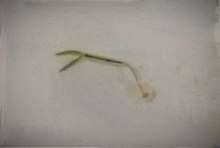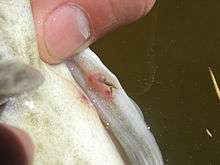Lernaea
Lernaea (also incorrectly spelled Lernea) is a genus of copepod crustaceans commonly called anchor worms, parasitic on freshwater fishes. They mate during the last free-swimming (copepodid) stage of development. After mating, the female burrows into the flesh of a fish and transforms into an unsegmented, wormlike form, usually with a portion hanging from the fish's body.[1]
| Lernaea | |
|---|---|
| Scientific classification | |
| Kingdom: | |
| Phylum: | |
| Subphylum: | |
| Class: | |
| Subclass: | |
| Order: | |
| Family: | Lernaeidae |
| Genus: | Lernaea |
[[File:


Diagnosis
Symptoms of anchor worm can be as follows:[2]
- Anchor worms (Lernaea) can be seen with the naked eye
- Frequent rubbing or "flashing"
- Localised redness
- Inflammation on the body of the fish
- Tiny white-green or red worms in wounds
- Breathing difficulties
- General lethargy
Treatment
There are several treatments for anchor worm in the aquarium/pond. Potassium permanganate is usually considered the best treatment and can be used either as a tank treatment or a "dip". Other treatments include a salt dip, a formalin dip, and modern antiparasitics may help. Salt in the aquarium at 1 to 2 tablespoons may help prevent secondary infections.[2]
Manual removal of the parasite is one of the surest ways to get rid of it; this can be done by holding the fish in the hand and removing the parasites with a pair of tweezers, being careful not to break the tail off leaving the head embedded and dipping the fish back into water every few seconds so it can breathe. Sometimes the parasite can burrow so deeply that pulling it out can cause more trauma than leaving it in and just treating it.[2]